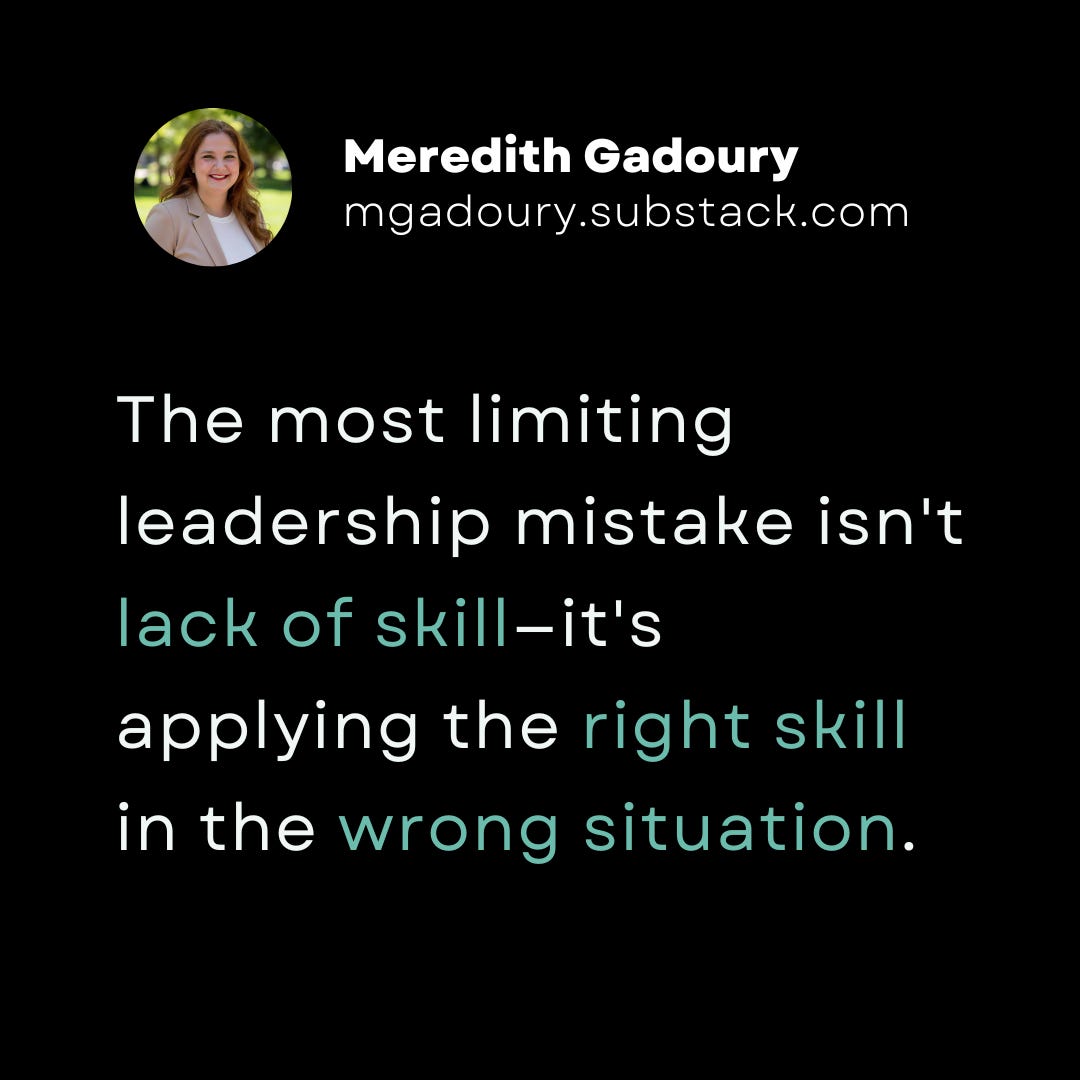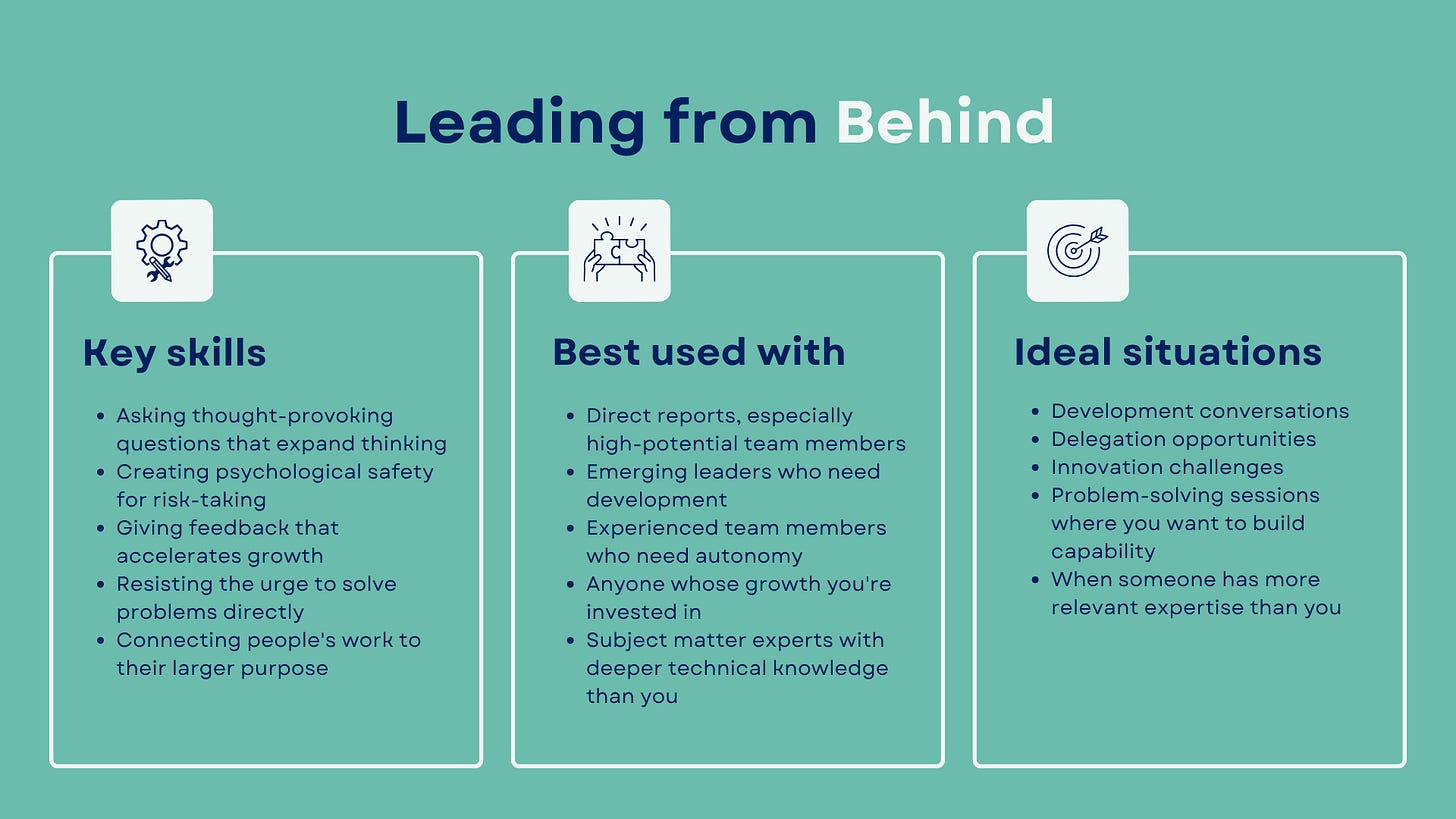Lead, Partner, or Coach? The Three Positions Every Leader Needs to Master
Matching your leadership approach to what each situation demands
Welcome to The Evolving Leader's Guide. Each week, I share one mindset, framework, or toolkit designed to help you become a more effective leader—so you can lead with confidence, inspire your team, and build a career you're proud of.
This week's tool: Directional Leadership
I promise this isn’t a bad joke…
Three leaders walk into a CEO's office with the same objective: get approval for a critical initiative.
The first product lead spends ten minutes explaining her detailed analysis. The CEO interrupts: "What's your recommendation?"
The second product lead opens with, "I'd like to explore this challenge collaboratively..." The CEO says “sure” and multi-tasks by answering some emails.
The third product leader starts: "We should integrate the AI recommendation engine next month. It's projected to increase average order value by 28% and reduce cart abandonment. I can share the competitive analysis if needed." The CEO nods and asks targeted questions.
Same facts. Same audience. Dramatically different outcomes.
What happened here? Each product leader used a valuable leadership skill. The first led with thorough reasoning and context. The second approached with collaborative partnership. The third provided clear direction and decisive recommendations.
The third product manager succeeded because she understood what the situation called for—she positioned herself in the right relationship to the CEO for that specific context.
I made this mistake myself last year. I was working with a fellow leadership coach on a workshop design. As the content expert, I kept driving the agenda forward, making quick decisions, and outlining next steps—exactly as I would have when I was leading my team.
After our third planning session, my colleague pulled me aside: "You know, this would go better if we collaborated as equals rather than you directing the process."
I was stunned. In my mind, I was being efficient. In his experience, I was being controlling.
That conversation revealed a blind spot many leaders face: Using the same approach regardless of context, rather than adapting to what each interaction requires. This concept—understanding where to position yourself relative to others in different situations—is called dimensional leadership.
A common leadership challenge isn't lack of skill—it's applying the right skill in the wrong situation.
Let me share the three leadership dimensions, when to use each one, and how to match your approach to any situation.
Three Leadership Dimensions
Leadership isn't just about what you say—it's about where you position yourself relative to others in each interaction.
Dimensional leadership focuses on the spatial relationship between you and the people you're working with. It's about consciously choosing your position—in front, beside, or behind—based on what will be most effective in each specific context.
This approach recognizes that leadership isn't fixed. The same person might need to lead differently in different situations, even within the same day or same meeting. The key is developing awareness of these dimensions and flexibility in shifting between them.
There are three key leadership dimensions:
Leading from in front: Providing clear direction, making decisions, and taking responsibility for outcomes. This dimension involves creating the path forward and giving clear guidance.
Leading from beside: Partnering as peers, collaborating equally, and finding solutions together. This dimension creates authentic partnership where diverse perspectives combine for better outcomes.
Leading from behind: Creating space for others to step forward, offering support without taking control, and developing capabilities. This dimension is about coaching and evoking leadership qualities in others.
The most effective leaders develop fluidity between these dimensions, knowing when each approach will create the greatest value. They recognize that no single position is inherently better than another—each has its place depending on the context, the relationship, and the desired outcome.
Let’s dive into each dimension a bit more.
Leading From In Front
When you lead from in front, you set direction, make decisions, and provide clarity. You're the pathfinder who sees the destination and charts the course.
Leading from in front aligns with the traditional view of leadership but goes deeper. It isn't about barking orders—it's about having a compelling vision, speaking with authority, and stepping into new vision while maintaining a strong connection with those following you.
Leading from in front breaks down when leaders lose touch with those they're leading. When you're so far ahead that you can't hear the footsteps behind you, you're no longer leading—you're just walking alone. This dimension also falters when leaders become inflexible, confusing confidence with rigidity, or when they focus solely on vision without building the connection needed for others to follow willingly.
Leading From Beside
When you lead from beside, you create a partnership of equals. You're not directing or following—you're walking alongside, combining strengths for mutual benefit.
This goes beyond simple collaboration or dividing responsibilities. Leading from beside creates a collective partnership between people who sometimes finish each other's sentences, give complete permission to disagree, and engage in constructive debate. Through this relationship, partners reach solutions neither could have developed alone.
This dimension crumbles when one person secretly wants to be in front but pretends to collaborate. It also fails when disagreements become personal rather than constructive, when power dynamics remain unaddressed, or when the focus on consensus prevents forward movement. True partnership requires genuine respect for different perspectives and the willingness to set aside ego to find that "third way" that's better than either person's original idea.
Leading From Behind
When you lead from behind, you create space for others to step forward. You're the enabler who removes obstacles, provides resources, and helps others succeed.
This dimension is about support and anticipation—not being passive, but actively enabling the purpose and vision that's unfolding. Leaders from behind notice when someone veers off track and asks questions that reconnect them with the vision. They're actively ensuring everyone remains connected and moving in the right direction.
Leading from behind falls apart when it becomes passive abdication rather than active empowerment. It fails when leaders don't provide enough initial context or resources, when they step in too quickly to solve problems, or when they focus so much on development that they neglect results. The most common mistake is confusing "hands-off" with leading from behind—true leaders in this dimension remain highly engaged, just in a different way.
Real-World Application Examples
Here's how directional leadership plays out across common scenarios:
In meetings: A skilled leader might open with clear direction about the meeting purpose (in front), facilitate a collaborative discussion among attendees (beside), then step back to let the team reach their own conclusions (behind).
During project planning: You might provide clear guardrails on budget and timeline (in front), work collaboratively with functional leaders on resource allocation (beside), then give your team autonomy to determine implementation details (behind).
In performance conversations: Start with clear expectations and feedback (in front), explore development goals collaboratively (beside), then coach them through creating their own improvement plan (behind).
When scaling operations: Establish non-negotiable standards and metrics (in front), partner with peer leaders to align on cross-functional processes (beside), then let managers adapt the approach to their teams (behind).
The key is recognizing which direction serves the moment and having the flexibility to adapt.
The Power of Position Shifting
Most leaders naturally excel in one dimension:
Decisive, action-oriented leaders prefer leading from in front
Collaborative, relationship-focused leaders favor leading from beside
Developmental, coaching-oriented leaders gravitate toward leading from behind
Leadership excellence requires proficiency in all three approaches.
The most effective leaders develop what I call "dimensional intelligence"—the ability to read a situation and fluidly shift between dimensions as needed. They understand that any dimension can be the right one depending on the context. Sometimes they'll move through all three dimensions in a single meeting.
I've watched leaders grow from one-dimensional operators to multidimensional masters. A technically brilliant leader who once led exclusively from in front learned to create space for her team's ideas (behind) and build stronger peer relationships across the organization (beside). The result wasn't just better outcomes—it was greater influence, deeper trust, and more sustainable results.
This flexibility becomes a leadership multiplier. It allows you to influence effectively in any context: up, across, or throughout the organization. It prevents the common trap of applying your preferred approach to situations that demand something different.
The higher you rise in an organization, the more this flexibility matters. Senior leaders don't just direct more people—they lead more adeptly, collaborate more effectively, and develop talent more intentionally.
Coach's Challenge:
This week, put directional leadership into practice:
Identify your default direction: Which approach do you naturally favor? In what situations does this serve you well? Where does it create friction?
Select three upcoming interactions: For each, intentionally choose the directional approach that best fits the context, even if it's not your default.
Prepare specifically: What words, questions, or opening statements will help you establish the right directional position?
Reflect on outcomes: After each interaction, note what worked and what you'd adjust next time.
Leadership direction isn't about status or hierarchy—it's about positioning yourself where you can be most effective for the situation and the person.
By mastering when to lead from in front, beside, and behind, you expand your leadership impact and create more value in every interaction.











